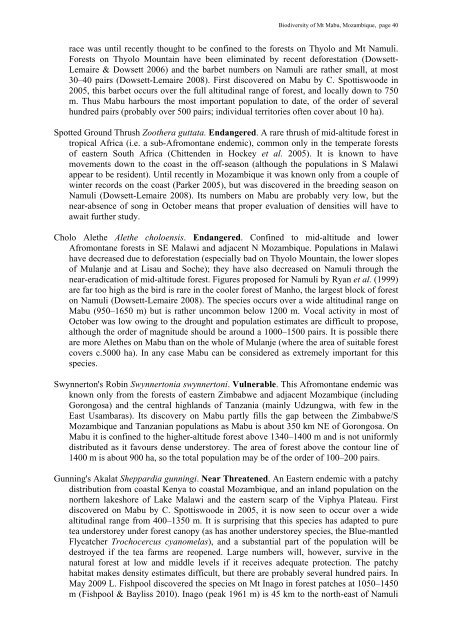MT MABU, MOZAMBIQUE: - Royal Botanic Gardens, Kew
MT MABU, MOZAMBIQUE: - Royal Botanic Gardens, Kew
MT MABU, MOZAMBIQUE: - Royal Botanic Gardens, Kew
Create successful ePaper yourself
Turn your PDF publications into a flip-book with our unique Google optimized e-Paper software.
Biodiversity of Mt Mabu, Mozambique, page 40<br />
race was until recently thought to be confined to the forests on Thyolo and Mt Namuli.<br />
Forests on Thyolo Mountain have been eliminated by recent deforestation (Dowsett-<br />
Lemaire & Dowsett 2006) and the barbet numbers on Namuli are rather small, at most<br />
30–40 pairs (Dowsett-Lemaire 2008). First discovered on Mabu by C. Spottiswoode in<br />
2005, this barbet occurs over the full altitudinal range of forest, and locally down to 750<br />
m. Thus Mabu harbours the most important population to date, of the order of several<br />
hundred pairs (probably over 500 pairs; individual territories often cover about 10 ha).<br />
Spotted Ground Thrush Zoothera guttata. Endangered. A rare thrush of mid-altitude forest in<br />
tropical Africa (i.e. a sub-Afromontane endemic), common only in the temperate forests<br />
of eastern South Africa (Chittenden in Hockey et al. 2005). It is known to have<br />
movements down to the coast in the off-season (although the populations in S Malawi<br />
appear to be resident). Until recently in Mozambique it was known only from a couple of<br />
winter records on the coast (Parker 2005), but was discovered in the breeding season on<br />
Namuli (Dowsett-Lemaire 2008). Its numbers on Mabu are probably very low, but the<br />
near-absence of song in October means that proper evaluation of densities will have to<br />
await further study.<br />
Cholo Alethe Alethe choloensis. Endangered. Confined to mid-altitude and lower<br />
Afromontane forests in SE Malawi and adjacent N Mozambique. Populations in Malawi<br />
have decreased due to deforestation (especially bad on Thyolo Mountain, the lower slopes<br />
of Mulanje and at Lisau and Soche); they have also decreased on Namuli through the<br />
near-eradication of mid-altitude forest. Figures proposed for Namuli by Ryan et al. (1999)<br />
are far too high as the bird is rare in the cooler forest of Manho, the largest block of forest<br />
on Namuli (Dowsett-Lemaire 2008). The species occurs over a wide altitudinal range on<br />
Mabu (950–1650 m) but is rather uncommon below 1200 m. Vocal activity in most of<br />
October was low owing to the drought and population estimates are difficult to propose,<br />
although the order of magnitude should be around a 1000–1500 pairs. It is possible there<br />
are more Alethes on Mabu than on the whole of Mulanje (where the area of suitable forest<br />
covers c.5000 ha). In any case Mabu can be considered as extremely important for this<br />
species.<br />
Swynnerton's Robin Swynnertonia swynnertoni. Vulnerable. This Afromontane endemic was<br />
known only from the forests of eastern Zimbabwe and adjacent Mozambique (including<br />
Gorongosa) and the central highlands of Tanzania (mainly Udzungwa, with few in the<br />
East Usambaras). Its discovery on Mabu partly fills the gap between the Zimbabwe/S<br />
Mozambique and Tanzanian populations as Mabu is about 350 km NE of Gorongosa. On<br />
Mabu it is confined to the higher-altitude forest above 1340–1400 m and is not uniformly<br />
distributed as it favours dense understorey. The area of forest above the contour line of<br />
1400 m is about 900 ha, so the total population may be of the order of 100‒200 pairs.<br />
Gunning's Akalat Sheppardia gunningi. Near Threatened. An Eastern endemic with a patchy<br />
distribution from coastal Kenya to coastal Mozambique, and an inland population on the<br />
northern lakeshore of Lake Malawi and the eastern scarp of the Viphya Plateau. First<br />
discovered on Mabu by C. Spottiswoode in 2005, it is now seen to occur over a wide<br />
altitudinal range from 400–1350 m. It is surprising that this species has adapted to pure<br />
tea understorey under forest canopy (as has another understorey species, the Blue-mantled<br />
Flycatcher Trochocercus cyanomelas), and a substantial part of the population will be<br />
destroyed if the tea farms are reopened. Large numbers will, however, survive in the<br />
natural forest at low and middle levels if it receives adequate protection. The patchy<br />
habitat makes density estimates difficult, but there are probably several hundred pairs. In<br />
May 2009 L. Fishpool discovered the species on Mt Inago in forest patches at 1050‒1450<br />
m (Fishpool & Bayliss 2010). Inago (peak 1961 m) is 45 km to the north-east of Namuli

















